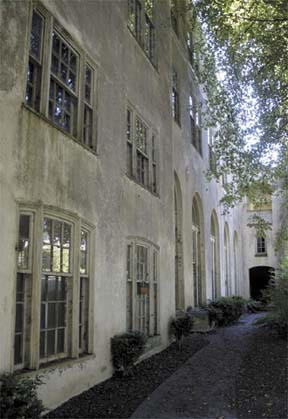The historical building could become an arts learning center.
Michael Bride has raised funds to preserve salmon and elephants; now he wants to save another sort of endangered species.
Bride, a Seattle native and insurance professional, wants to turn the historic Moran School building at Rolling Bay into an art space.
The Italianate stucco building next to Messenger House has stood vacant for a half-century.
“I was out visiting friends on Rolling Bay walk three and a half years ago,” Bride said. “When we drove past the buildings I was instantly intrigued. One look at those arched windows was all it took.”
Bride toured the site two years ago, with island architect Miles Yanick and attorney Kate Carruthers. Bride said the building owner, Tacoma-based Sound Care, Inc., wasn’t inclined to sell at that time, but recently contacted him,
Bride says he became hooked on the building’s history, a dramatic story featuring romance, fire and a massive explosion, a tale that unfolded over 85 years spanning the advent of the automobile, the first talking pictures and both world wars.
When it was purchased in 1914 by Frank Moran – scion of a pioneering Seattle family risen to prominence through shipbuilding and political savvy – the 40 acres at Skiff Point near Rolling Bay had already been the locus of an unsuccessful summer hotel.
Boasting views of Seattle and Mt. Rainier, the prime acreage was developed first into a prep school, the Moran School for Boys, and then a junior college.
The school was first housed in the old hotel and later expanded into three stucco buildings, one of which was lost in an explosion. A second building would be turned into a nursing home by the mid-1950s, but the third building – Bride’s prize – housed the Moran School’s 150-seat movie theater on the two-story ground floor, with classrooms and dormitories on two floors above.
An eyewitness to the building’s lively history – he recalls students ariving for the semester by horse and buggy – 90-year-old Bill Weld still lives nearby at Manitou Beach.
Weld was promoted to theater projectionist from his job raising the theater’s velvet maroon curtain, after the students responsible for running the films – distracted by a bevvy of local beauties – failed to notice that the evening’s feature had caught fire.
The school closed its doors in 1933, a casualty of the Great Depression, but was purchased by Joseph Hill five years later and re-opened as Puget Sound Naval Academy – a military prep school readying boys for the Coast Guard Academy and U.S. Naval Academy.
When, after World War II, the academy leased a 135-foot, two-and-a-half-ton Navy minesweeper for training, it was Weld who became the ship’s skipper after just two hours of casual instruction.
“They delivered the minesweeper and the navy guy talked to me for a little while in the ship’s engine room,” Weld said, “and then they piled back into their boat and left.”
When the naval academy closed in 1951, one building was retooled as a nursing home, now known as Messenger House.
But the second stood empty, except for a brief transformation, in 2000, into a movie set for the independent feature “Farewell to Harry” by an island-based movie production company.
Bride’s plan for the Moran School building and an adjacent cottage dovetail with the structure’s theatrical and pedagogical history.
“First and foremost, my passion is to restore the building and make it a community setting for arts mentorship programs,” Bride said.
He envisions preserving the two-story auditorium and developing spaces for such arts activities as theater training, textiles, quilting and music.
“They’d all be done in a really peaceful setting that supports people honing their craft,” Bride said. “And whatever arts were being trained or mentored, there would be a focus on the historic evolution of that art form.”
The focus on craftsmanship would begin with the building’s restoration. While Bride admits renovating the structure would take a massive fund-raising effort, he is no stranger to such projects.
Among the 31-year-old’s credits is “My Fresh Look,” which provides haircuts and cosmetic makeovers on woman on welfare or homeless to ready them for job interviews. He also has been organizing rafting trips for years on Washington rivers to raise money for a Seattle-based salmon conservation fund.
“When he first called me, I thought ‘oh here’s this crazy guy, he has no idea what he’s in for,’” Yanick said. “Except, he’s stuck to it for more than two years now. He’s got this dream, and he just may be serious enough to pull it off.”
State money may be available for the project, Yanick points out, since the the building may well be eligible for inclusion in the state historic register.
Bride hopes to enlist more islanders passionate about saving the landmark building.
Bride has assembled an advisory board that includes islanders like Yanick and Michael Wynne-Jones, a senior vice-president for a Seattle-based re-insurance firm; together with Seattle residents like Theresa Donich, who directs Briazz food service, and Dennis Haynes, an administrator for Raising More Money, a firm training nonprofits in fund-raising.
The Moran group will apply for nonprofit status, Bride says.
“It’s really been a process of figuring out what order to put the ducks in,” Bride said. “At this point it’s kind of seeing who’s on board. We want people who are passionate about it, and want to share that passion with others.
“There’s a well of untapped devotion out there.”
For information about Moran School preservation, call 235-5590.



